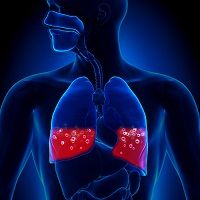Article
Study Finds Distinct Damage in Explanted Lung Tissue of PH-COPD Patients
Author(s):
Little is known on the underlying pulmonary arterial lesions in patients with this phenotype of COPD.

A recent study found that explanted lung tissue from chronic obstructive pulmonary disease (COPD) patients with severe pulmonary hypertension (PH) shows a specific histological pattern that includes muscularization of the microvessels and lower capillary density compared to those with moderate PH and those without.
The prevalence of pulmonary hypertension is not known, but there are about 200,000 hospitalizations a year in the US with PH as the primary or secondary diagnosis, according to the American Thoracic Society. Treatments include various medications administered orally, by inhalation, intravenously, or subcutaneously, and stem cell therapy. The last line of treatment is a lung transplant.
The World Health Organization (WHO) has classified 5 different kinds of pulmonary hypertension that are most prevalent with certain health conditions: pulmonary arterial hypertension (PAH); PH due to left heart disease, PH due to lung disease, PH due to chronic blood clots, and PH of unknown cause.
Most COPD patients with PH fall into the WHO 3 classification for PH; disease progress is slower, with a mean pulmonary artery pressure (mPAP) between 25 and 35 mmHg and adequate cardiac output. For this study, investigators wanted to study the small minority of COPD patients with severe PH who have a mPAP of 35 mmHg or greater, or an mPAP of 25 or greater with a low cardiac index.
“In this phenotype of COPD, patients with particular involvement of the pulmonary circulation, little is known on the underlying pulmonary arterial lesions,” investigators wrote.
The study began with 200 patients with COPD or a1-antitryosin (AAT) deficiency that received lung transplants between March 1988 and June 2015 at the Bichat Hospital in Paris, France. After excluding 61 patients, of the remaining 139, 10 had severe PH-COPD. Of the 129, investigators randomly selected 10 with moderate PH and 10 without PH.
The remodeling score of the microvessels (muscularization) in the explanted lungs of patients with severe PH were much higher (1.284 vs. 0.867, P= .0045) than those with moderate PH. Capillary density was also lower (0.00235/μm2 vs. 0.00525/μm2, P= .0049). Lesions indicative of PAH were not found.
Some limitations include the low number of PH-COPD patients and using only explanted lungs from those with end-stage disease. However, investigators stated a significant strength of their results are that it gives morphometric data on the lesions associated with some forms of pulmonary hypertension and sheds light on the action of the pulmonary arterioles and the capillary beds in COPD.
This study, “Pulmonary Arterial Histological Lesions in COPD with Severe Pulmonary Hypertension”, was published in Chest.





